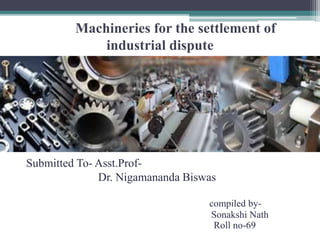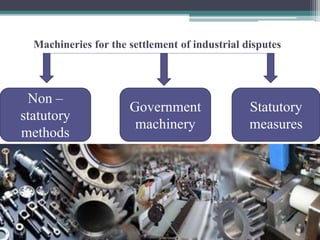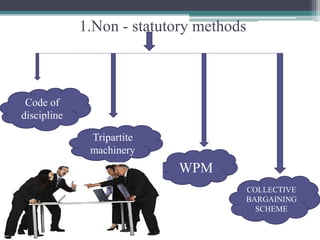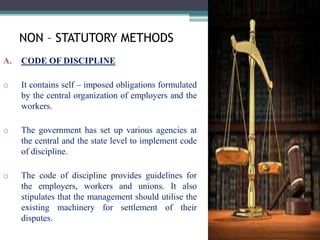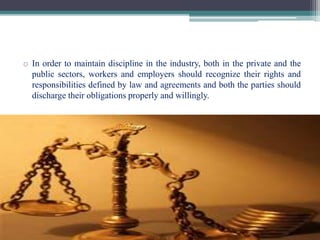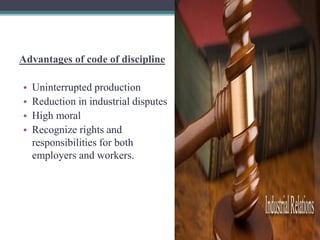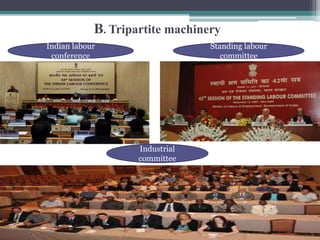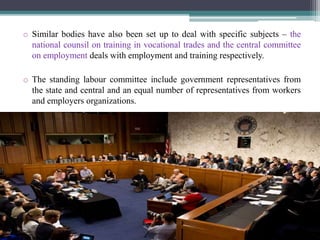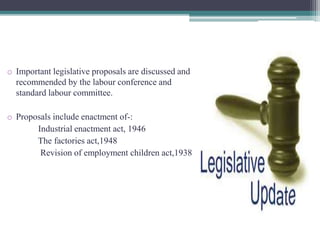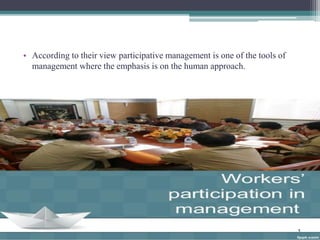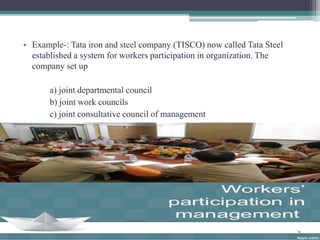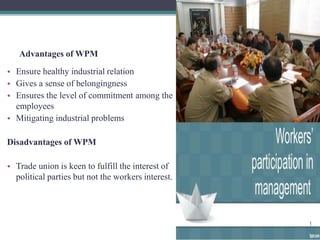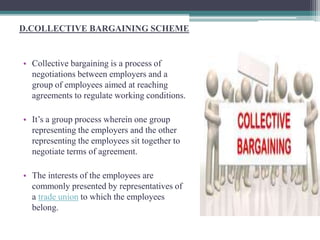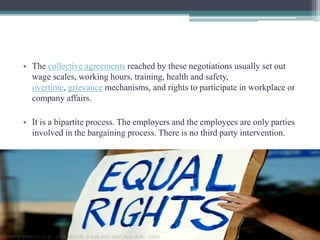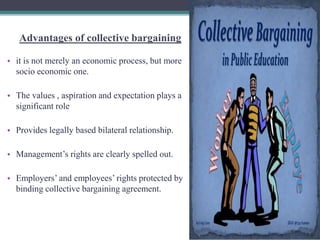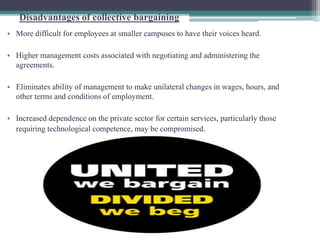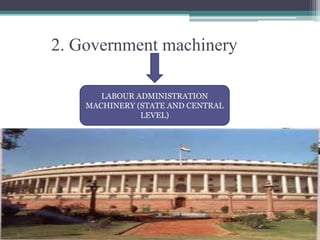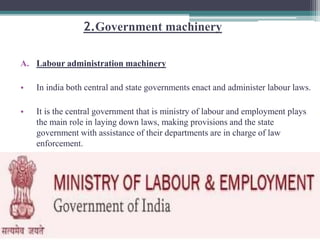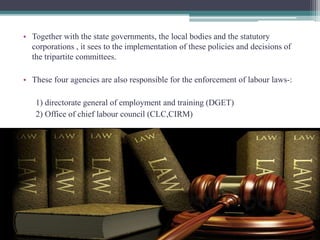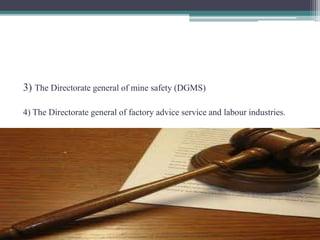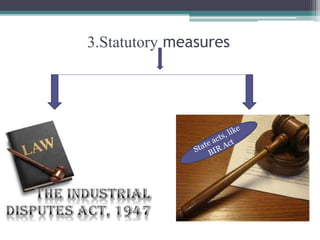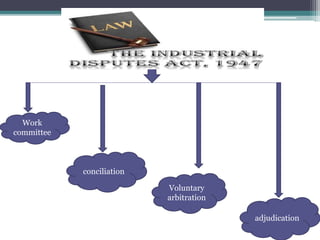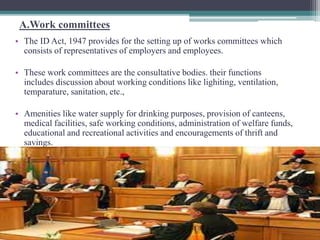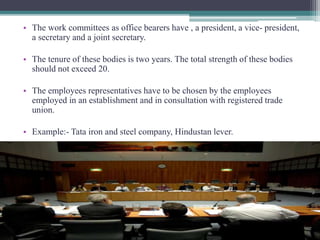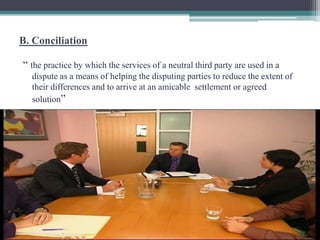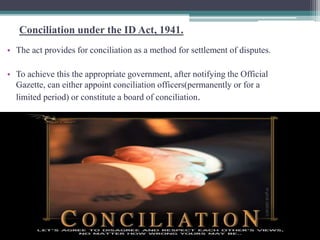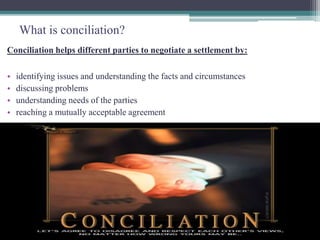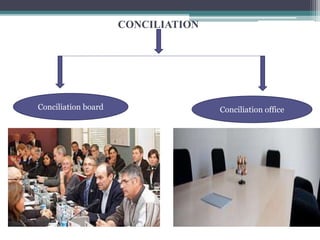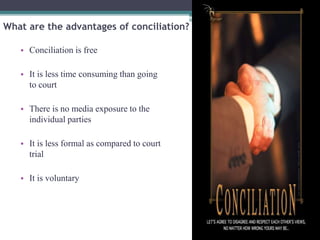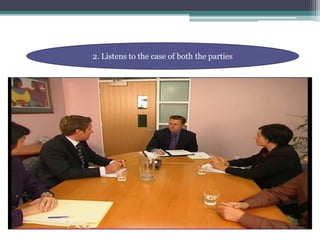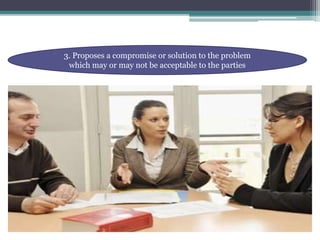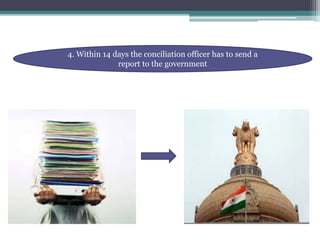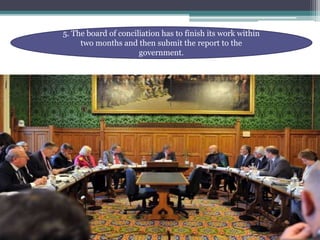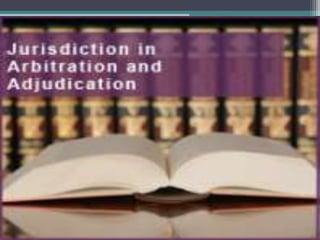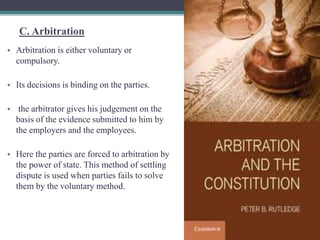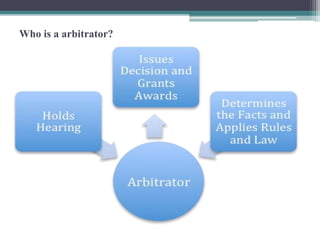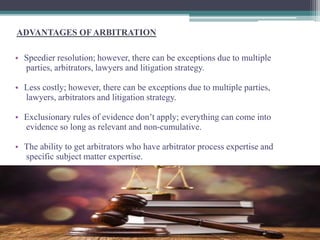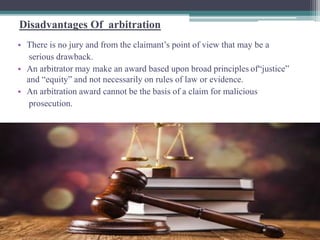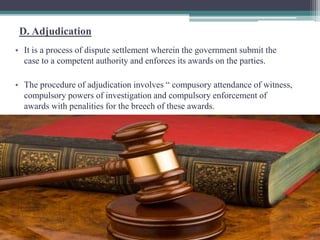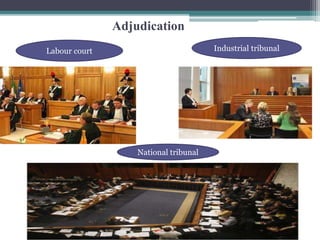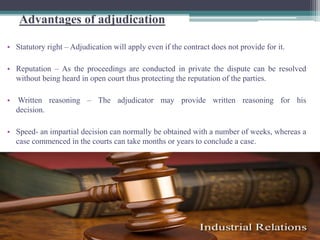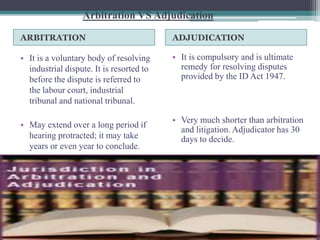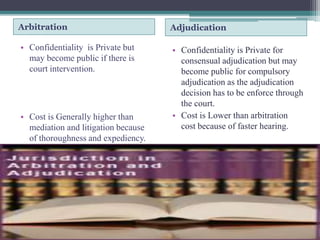Grievance machinery
- 1. Machineries for the settlement of industrial dispute Submitted To- Asst.Prof- Dr. Nigamananda Biswas compiled by- Sonakshi Nath Roll no-69
- 2. Machineries for the settlement of industrial disputes Non – statutory methods Government machinery Statutory measures
- 3. 1.Non - statutory methods Code of discipline Tripartite machinery WPM COLLECTIVE BARGAINING SCHEME
- 4. NON – STATUTORY METHODS A. CODE OF DISCIPLINE o It contains self – imposed obligations formulated by the central organization of employers and the workers. o The government has set up various agencies at the central and the state level to implement code of discipline. o The code of discipline provides guidelines for the employers, workers and unions. It also stipulates that the management should utilise the existing machinery for settlement of their disputes.
- 5. o In order to maintain discipline in the industry, both in the private and the public sectors, workers and employers should recognize their rights and responsibilities defined by law and agreements and both the parties should discharge their obligations properly and willingly.
- 6. Advantages of code of discipline • Uninterrupted production • Reduction in industrial disputes • High moral • Recognize rights and responsibilities for both employers and workers.
- 7. B. Tripartite machinery Indian labour conference Standing labour committee Industrial committee
- 8. o Similar bodies have also been set up to deal with specific subjects – the national counsil on training in vocational trades and the central committee on employment deals with employment and training respectively. o The standing labour committee include government representatives from the state and central and an equal number of representatives from workers and employers organizations.
- 9. o Important legislative proposals are discussed and recommended by the labour conference and standard labour committee. o Proposals include enactment of-: Industrial enactment act, 1946 The factories act,1948 Revision of employment children act,1938
- 10. Advantages of tripartite machinery • Powerful instrument in the formulation of labour policy • Its legal framework plays a vital role in reducing industrial disputes.
- 11. C. WORKERS’ PARTICIPATION IN MANAGEMENT • The concept of workers’ participation in management is considered as a mechanism where workers have a say in the decision making process of an enterprise. • In view of social thinkers like Comte and owen, workers participation in management should be encouraged for achieving social justice.
- 12. • According to their view participative management is one of the tools of management where the emphasis is on the human approach.
- 13. • Example-: Tata iron and steel company (TISCO) now called Tata Steel established a system for workers participation in organization. The company set up a) joint departmental council b) joint work councils c) joint consultative council of management
- 14. Advantages of WPM • Ensure healthy industrial relation • Gives a sense of belongingness • Ensures the level of commitment among the employees • Mitigating industrial problems Disadvantages of WPM • Trade union is keen to fulfill the interest of political parties but not the workers interest.
- 15. D.COLLECTIVE BARGAINING SCHEME • Collective bargaining is a process of negotiations between employers and a group of employees aimed at reaching agreements to regulate working conditions. • It’s a group process wherein one group representing the employers and the other representing the employees sit together to negotiate terms of agreement. • The interests of the employees are commonly presented by representatives of a trade union to which the employees belong.
- 16. • The collective agreements reached by these negotiations usually set out wage scales, working hours, training, health and safety, overtime, grievance mechanisms, and rights to participate in workplace or company affairs. • It is a bipartite process. The employers and the employees are only parties involved in the bargaining process. There is no third party intervention.
- 17. Advantages of collective bargaining • it is not merely an economic process, but more socio economic one. • The values , aspiration and expectation plays a significant role • Provides legally based bilateral relationship. • Management’s rights are clearly spelled out. • Employers’ and employees’ rights protected by binding collective bargaining agreement.
- 18. Disadvantages of collective bargaining • More difficult for employees at smaller campuses to have their voices heard. • Higher management costs associated with negotiating and administering the agreements. • Eliminates ability of management to make unilateral changes in wages, hours, and other terms and conditions of employment. • Increased dependence on the private sector for certain services, particularly those requiring technological competence, may be compromised.
- 19. 2. Government machinery LABOUR ADMINISTRATION MACHINERY (STATE AND CENTRAL LEVEL)
- 20. 2.Government machinery A. Labour administration machinery • In india both central and state governments enact and administer labour laws. • It is the central government that is ministry of labour and employment plays the main role in laying down laws, making provisions and the state government with assistance of their departments are in charge of law enforcement.
- 21. • Together with the state governments, the local bodies and the statutory corporations , it sees to the implementation of these policies and decisions of the tripartite committees. • These four agencies are also responsible for the enforcement of labour laws-: 1) directorate general of employment and training (DGET) 2) Office of chief labour council (CLC,CIRM)
- 22. 3) The Directorate general of mine safety (DGMS) 4) The Directorate general of factory advice service and labour industries.
- 24. Work committee conciliation Voluntary arbitration adjudication
- 25. A.Work committees • The ID Act, 1947 provides for the setting up of works committees which consists of representatives of employers and employees. • These work committees are the consultative bodies. their functions includes discussion about working conditions like lighiting, ventilation, temparature, sanitation, etc., • Amenities like water supply for drinking purposes, provision of canteens, medical facilities, safe working conditions, administration of welfare funds, educational and recreational activities and encouragements of thrift and savings.
- 26. • The work committees as office bearers have , a president, a vice- president, a secretary and a joint secretary. • The tenure of these bodies is two years. The total strength of these bodies should not exceed 20. • The employees representatives have to be chosen by the employees employed in an establishment and in consultation with registered trade union. • Example:- Tata iron and steel company, Hindustan lever.
- 27. B. Conciliation “ the practice by which the services of a neutral third party are used in a dispute as a means of helping the disputing parties to reduce the extent of their differences and to arrive at an amicable settlement or agreed solution”
- 28. Conciliation under the ID Act, 1941. • The act provides for conciliation as a method for settlement of disputes. • To achieve this the appropriate government, after notifying the Official Gazette, can either appoint conciliation officers(permanently or for a limited period) or constitute a board of conciliation.
- 29. What is conciliation? Conciliation helps different parties to negotiate a settlement by: • identifying issues and understanding the facts and circumstances • discussing problems • understanding needs of the parties • reaching a mutually acceptable agreement
- 30. CONCILIATION Conciliation board Conciliation office
- 31. What are the advantages of conciliation? • Conciliation is free • It is less time consuming than going to court • There is no media exposure to the individual parties • It is less formal as compared to court trial • It is voluntary
- 32. Process of conciliation 1. Bring the two parties together
- 33. 2. Listens to the case of both the parties
- 34. 3. Proposes a compromise or solution to the problem which may or may not be acceptable to the parties
- 35. 4. Within 14 days the conciliation officer has to send a report to the government
- 36. 5. The board of conciliation has to finish its work within two months and then submit the report to the government.
- 38. C. Arbitration • Arbitration is either voluntary or compulsory. • Its decisions is binding on the parties. • the arbitrator gives his judgement on the basis of the evidence submitted to him by the employers and the employees. • Here the parties are forced to arbitration by the power of state. This method of settling dispute is used when parties fails to solve them by the voluntary method.
- 39. Who is a arbitrator?
- 40. ADVANTAGES OF ARBITRATION • Speedier resolution; however, there can be exceptions due to multiple parties, arbitrators, lawyers and litigation strategy. • Less costly; however, there can be exceptions due to multiple parties, lawyers, arbitrators and litigation strategy. • Exclusionary rules of evidence don’t apply; everything can come into evidence so long as relevant and non-cumulative. • The ability to get arbitrators who have arbitrator process expertise and specific subject matter expertise.
- 41. Disadvantages Of arbitration • There is no jury and from the claimant’s point of view that may be a serious drawback. • An arbitrator may make an award based upon broad principles of“justice” and “equity” and not necessarily on rules of law or evidence. • An arbitration award cannot be the basis of a claim for malicious prosecution.
- 42. D. Adjudication • It is a process of dispute settlement wherein the government submit the case to a competent authority and enforces its awards on the parties. • The procedure of adjudication involves “ compusory attendance of witness, compulsory powers of investigation and compulsory enforcement of awards with penalities for the breech of these awards.
- 43. Adjudication Labour court Industrial tribunal National tribunal
- 44. Advantages of adjudication • Statutory right – Adjudication will apply even if the contract does not provide for it. • Reputation – As the proceedings are conducted in private the dispute can be resolved without being heard in open court thus protecting the reputation of the parties. • Written reasoning – The adjudicator may provide written reasoning for his decision. • Speed- an impartial decision can normally be obtained with a number of weeks, whereas a case commenced in the courts can take months or years to conclude a case.
- 45. Arbitration VS Adjudication ARBITRATION ADJUDICATION • It is a voluntary body of resolving industrial dispute. It is resorted to before the dispute is referred to the labour court, industrial tribunal and national tribunal. • May extend over a long period if hearing protracted; it may take years or even year to conclude. • It is compulsory and is ultimate remedy for resolving disputes provided by the ID Act 1947. • Very much shorter than arbitration and litigation. Adjudicator has 30 days to decide.
- 46. Arbitration Adjudication • Confidentiality is Private but may become public if there is court intervention. • Cost is Generally higher than mediation and litigation because of thoroughness and expediency. • Confidentiality is Private for consensual adjudication but may become public for compulsory adjudication as the adjudication decision has to be enforce through the court. • Cost is Lower than arbitration cost because of faster hearing.

